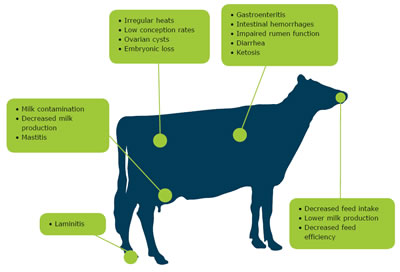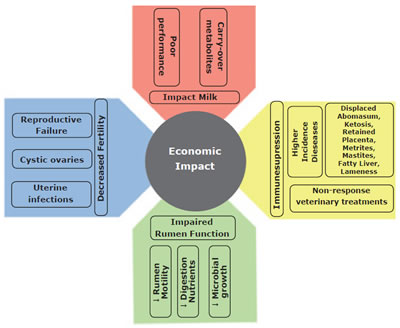Mycotoxins in Dairy Cows: A Menace To Cows, Farmers and Consumers!
The primary objective of dairy farmers is to optimize milk production and remain profitable over the long term. This isn't simple given the volatility of the feed markets, milk prices, changing consumer preferences, and other constraints. Dairymen work to keep their cows healthy and productive, which again, isn't always easy. Naturally occurring toxic contaminants in feedstuffs, which can adversely affect animal performance and health, are an ever present threat.
That mycotoxins suppress the immune system and affect the normal functioning of major organs including the rumen, intestinal tract, liver, kidneys, reproductive system, nervous system, etc. is well documented. Down on the dairy farm, the incidence of diseases such as displaced abomasum, ketosis, retained placenta, metrites, mastitis and fatty livers increases with mycotoxin exposure. Mycotoxin induced diseases seldom respond if at all to veterinary therapy and result in increasing losses if only veterinary solutions are pursued. Furthermore, ration adjustments and management changes (grouping, cow movement, stall allotment, etc.) are of little value although they may be a factor in predisposition to mycotoxicoses. Initially, mycotoxins, such as aflatoxins and trichothecenes, act on the immune system (number of macrophages, lymphocytes and erythrocytes) reducing the animal's response to challenges. At higher levels they affect rumen (reduced concentration of microorganisms, decreased rumen motility) and other organ functions (gut, liver, kidneys, reproductive system, neural tissue, etc.) which can be exhibited as ketosis, fatty liver syndrome, reduced dry matter intake, reduced milk production, and by making the animals less responsive to treatments.

Figure 1 - Mycotoxins impact in dairy cows
Another aspect that should be taken into account is the higher incidence of lameness on dairy farms contaminated with mycotoxins. Lameness alone in dairy farms already causes large financial losses due to a decreased milk production, impaired reproductive performance and higher culling and veterinary costs. In a study conducted in 2005 by Özsoy S, et al., a positive relationship was established between aflatoxin contamination of feed, lameness (subclinical laminitis) and impaired fertility (cystic ovaries).
For these animals with a completely developed forestomachsystem, the rumen fluid content is, for certain mycotoxins such as ochratoxin A, zearalenone, T-2 toxin, diacetoxyscirpenol and deoxynivalenol, a detoxifying barrier with protozoa being significantly more active than bacteria. For this reason, it is often thought that ruminants are protected against the harmful effects of mycotoxins due to the action of ruminal microorganisms. However, other aspects should be taken into account before disregarding mycotoxins' hazardous effects in ruminants. First of all, for some of these toxic compounds namely aflatoxin and zearalenone, metabolic by-products are as toxic as or more toxic than the original molecules. Secondly, it should always be considered that mycotoxins will adversely impact rumen environment and activity even before having an effect on the animals themselves. Decreases in ruminal motility, on DM, ADF and starch digestion and on microbial growth are some of the impacts seen in animals fed mycotoxin contaminated diets
Aflatoxins
Early indications of aflatoxin toxicity include reduction in feed intake followed by weight loss or a slower rate of gain. Also, there is usually a decline in feed efficiency, increased susceptibility to stress, and poor reproductive performance. Calves are more susceptible than older animals. Chronic aflatoxicosis is characterized by unthriftiness; anorexia; a drying and peeling of skin on the muzzle; prolapse of the rectum; liver damage; elevated levels of blood constituents; and edema in the abdominal cavity. Milk production may drop dramatically in dairy cows fed aflatoxin-contaminated feed. Almost any level of aflatoxin-contaminated feedstuff in the ration may lead to some liver damage, especially in young animals. Histopathological findings include cholangiectasis, loss of liver cell glycogen, fatty degeneration, fibroblastic proliferation and perivascular edema – all of which are seen in the liver. Scientific reports show that aflatoxins are degraded in a low extent (less than 10%) when added to the ruminal fluid at concentrations from 1 to 10 ?g/mL (Yiannikouris et al., 2002). Metabolisation into aflatoxicol, a highly toxic aflatoxin B1 derivative, has also been detected. Low conception rate, cystic ovaries and uterine infection were observed in dairy animals consuming a naturally aflatoxin-contaminated diet.
In the case of aflatoxins, not only the decrease in the productivity and the impact on animal health should be considered. Aflatoxins are considered carcinogenic by the Institute of Applied Research on Cancer (IARC). The carry-over of aflatoxin residues into the milk should not be ignored as legislation exists worldwide limiting the concentration of AfM1– the milk metabolite of AfB1 – in milk (namely: 0.5 ppb in the USA and 0.05 ppb in the EU). Aflatoxin M1 appears in the milk within hours of consumption and returns to baseline levels within two or three days after removal of contaminated feed from the diet.
Deoxynivalenol
Deoxynivalenol (vomitoxin, DON) is a mold toxin produced by Fusarium species. It has been associated with reduced feed intake, unthriftiness, reduced weight gain, and decreased performance. Other symptoms include diarrhea, abortion, hemorrhage, hematological changes, and nervous disturbances. The impact of DON in dairy cattle is not well understood, but clinical data shows an association between DON intake and poor performance. Deoxynivalenol may, therefore, be a marker for low-quality mycotoxin-contaminated feed in these herds. Other field reports help substantiate a link between DON and poor performing dairy herds and it has also been associated with reduced feed intake in non-lactating dairy cattle.
T-2 toxin
T-2 toxin is a very potent Type-A trichothecene, produced by Fusarium fungi. In cattle it has been associated with gastroenteritis, intestinal hemorrhages and death. T-2 toxin has also been related to feed refusal and gastrointestinal lesions, bloody diarrhea, low feed consumption, decreased milk production, and absence of estrus cycles. Observations in dairy herds affected with T-2 toxin at dietary levels of 300 to 500 ppb suggest that T-2 toxin reduces milk production, hinders adjustment of fresh cows to the lactation diet, causes diarrhea and intestinal irritation, and increases culling and death rates.
Zearalenone
Zearalenone (ZEA) is an estrogenic metabolite of several species of Fusarium which has been reported to occur in silage, corn and other grains such as soybean, wheat, barley, oats, sorghum, sesame seed, and hay in many areas of the world. Chemically, zearalenone shows a similar configuration to estradiol enabling it to connect to cytoreceptors, thus causing estrogenic effects as well as abnormal estrus. More than 90% of ingested zearalenone is known to be converted into ?-zearalenol (about 10 times more estrogenic) in the rumen and to a lesser extent to ?-zearalenol (lower toxicity). Artificial insemination (AI) index rose from 1.2 to 4 in a dairy farm in England where poor-quality hay was being used. In another case-study, vulvar mucous discharge, repeated AI, increased culling due to infertility and difficult heat detection were observed when animals were fed hay and silage which tested positive for ZEA contamination.
Fumonisins
Fumonisins are mainly produced by Fusarium verticillioides (syn. moniliforme) as well as by Fusarium proliferatum and they occur predominately in maize and maize-based feeds. Dairy cattle (Holsteins and Jerseys) fed diets containing 100 ppm fumonisins for approximately seven days prior to freshening and 70 days thereafter demonstrated lower milk production (a reduction of 13.22 pounds or 6 kg per cow per day), explained primarily by reduced feed consumption. Higher levels of serum enzyme concentrations found suggested liver disease.
Ochratoxins
Ochratoxin A is a nephrotoxic mycotoxin formed by Aspergillus and Penicillium spp.. Experimental examinations of 30 day old calves which received 0.1-0.5 mg ochratoxin A/ kg LM (live mass) daily over a period of four weeks, showed polyuria, depression, decreased weight gain, low specific gravity of urine and dehydration. At necropsy, grayish colored kidneys and a mild enteritis were seen. Histopathological findings compricomprised of slight tubular degeneration with abundant eosinophilic, hyalinic material as a sign of deposition of protein into the tubules and Bowmann's capsules. Furthermore, necrosis of the epithelium of proximal tubules and intersticial fibrosis occurred. Ochratoxin A was also found combined with citrinin, a metabolic product produced by the same fungi, at concentrations of 1-2 mg/kg feed (88% DM).
Economic Impact
Contradictory data may be available in literature concerning mycotoxin's toxicity. However, one should always interpret information taking into account that animal production is a very dynamic process where many interactant factors are present. Mycotoxins are a serious problem per se. The existence of other toxins, unbalanced nutrition, poor hygiene, hard weather conditions and/or pathological problems in the herd at the same time as mycotoxin exposure, are likely to amplify their negative effects. The economic impact of mycotoxins on a dairy herd arises from the different effects mycotoxins have on the animals, as schematically explained in Figure 2.

Figure 2 - Mycotoxins impact in dairy production
The presence of mycotoxins in feed can hit all animal producers hard. Loss of productivity, and sometimes loss of the finished product can result from feeding grains with high levels of mycotoxins. Among the most affected species are high producing dairy cattle. The importance of quality feedstuffs to producers can mean the difference between profit and loss. Effectively reducing the amount of mycotoxins in feed is oftentimes critical to achieving the best production.
As it is stated in this newsletter and in other publications, many mycotoxins can impair the health and productivity of dairy animals. Based on this information, we should wonder why dairymen and their veterinarians do not employ a mycotoxin deactivator more often than they do. Unfortunately, when they do, it is usually a last resort since nothing else has solved their problem.
For more information please visit www.biomin.net








 BIOMIN Holding GmbH
BIOMIN Holding GmbH +43 2782 803 0
+43 2782 803 0






